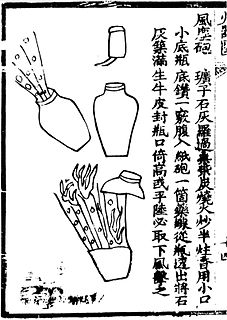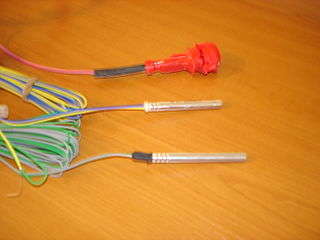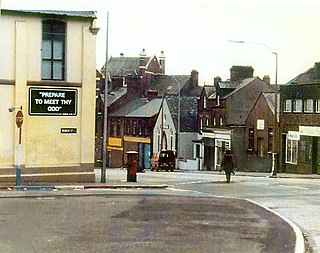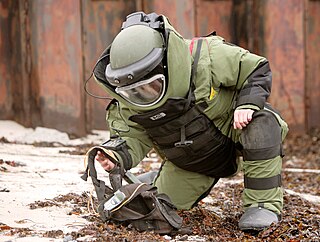
An explosive is a reactive substance that contains a great amount of potential energy that can produce an explosion if released suddenly, usually accompanied by the production of light, heat, sound, and pressure. An explosive charge is a measured quantity of explosive material, which may either be composed solely of one ingredient or be a mixture containing at least two substances.

A bomb is an explosive weapon that uses the exothermic reaction of an explosive material to provide an extremely sudden and violent release of energy. Detonations inflict damage principally through ground- and atmosphere-transmitted mechanical stress, the impact and penetration of pressure-driven projectiles, pressure damage, and explosion-generated effects. Bombs have been utilized since the 11th century starting in East Asia.

A nuclear bunker buster, also known as an earth-penetrating weapon (EPW), is the nuclear equivalent of the conventional bunker buster. The non-nuclear component of the weapon is designed to penetrate soil, rock, or concrete to deliver a nuclear warhead to an underground target. These weapons would be used to destroy hardened, underground military bunkers or other below-ground facilities. An underground explosion releases a larger fraction of its energy into the ground, compared to a surface burst or air burst explosion at or above the surface, and so can destroy an underground target using a lower explosive yield. This in turn could lead to a reduced amount of radioactive fallout. However, it is unlikely that the explosion would be completely contained underground. As a result, significant amounts of rock and soil would be rendered radioactive and lofted as dust or vapor into the atmosphere, generating significant fallout.

A detonator, frequently a blasting cap, is a device used to trigger an explosive device. Detonators can be chemically, mechanically, or electrically initiated, the last two being the most common.

Bomb disposal is an explosives engineering profession using the process by which hazardous explosive devices are rendered safe. Bomb disposal is an all-encompassing term to describe the separate, but interrelated functions in the military fields of explosive ordnance disposal (EOD) and improvised explosive device disposal (IEDD), and the public safety roles of public safety bomb disposal (PSBD) and the bomb squad.

Nuclear weapon designs are physical, chemical, and engineering arrangements that cause the physics package of a nuclear weapon to detonate. There are three existing basic design types:

An improvised explosive device (IED) is a bomb constructed and deployed in ways other than in conventional military action. It may be constructed of conventional military explosives, such as an artillery shell, attached to a detonating mechanism. IEDs are commonly used as roadside bombs.
The Explosive Ordnance Disposal Badge is a military badge of the United States Armed Forces which recognizes those service members, qualified as explosive ordnance disposal (EOD) technicians, who are specially trained to deal with the construction, deployment, disarmament, and disposal of high explosive munitions including other types of ordnance such as nuclear, biological and chemical weapons along with improvised explosive devices (IED) and improvised nuclear devices (IND). Also known as the “EOD Badge” or "Crab", the decoration is issued by the United States Army, Air Force, Navy and Marine Corps. The EOD Badge is the only occupational badge awarded to all four services under the United States Department of Defense.

United States Navy Explosive Ordnance Disposal technicians render safe all types of ordnance, including improvised, chemical, biological, and nuclear. They perform land and underwater location, identification, render-safe, and recovery of foreign and domestic ordnance. They conduct demolition of hazardous munitions, pyrotechnics, and retrograde explosives using detonation and burning techniques. They forward deploy and fully integrate with the various Combatant Commanders, Special Operations Forces (SOF), and various warfare units within the Navy, Marine Corps, Air Force and Army. They are also called upon to support military and civilian law enforcement agencies, as well as the Secret Service.

An ammunition technician (AT) is a British Army soldier, formerly of the Royal Army Ordnance Corps but since 1993 of the Royal Logistic Corps, trained to inspect, repair, test, store, and modify all ammunition, guided missiles, and explosives used by the British Army. These technicians are also trained to use demolition to safely dispose of individual items of ammunition and explosives (EODs) or to conduct logistics disposal of bulk stocks of multi items. After gaining sufficient experience, those who show the appropriate qualities are given extra training to render safe improvised explosive devices (IEDs) by a process called improvised explosive device disposal. Experienced ATs may be called to give evidence as expert witnesses in criminal or coroner's courts in relation to ammunition or explosives or to EOD and IEDD duties.

Explosives safety originated as a formal program in the United States in the aftermath of World War I when several ammunition storage areas were destroyed in a series of mishaps. The most serious occurred at Picatinny Arsenal Ammunition Storage Depot, New Jersey, in July, 1926 when an electrical storm led to fires that caused explosions and widespread destruction. The severe property damage and 19 fatalities led Congress to empower a board of Army and Naval officers to investigate the Picatinny Arsenal disaster and determine if similar conditions existed at other ammunition depots. The board reported in its findings that this mishap could recur, prompting Congress to establish a permanent board of colonels to develop explosives safety standards and ensure compliance beginning in 1928. This organization evolved into the Department of Defense Explosives Safety Board (DDESB) and is chartered in Title 10 of the US Code. The DDESB authors Defense Explosives Safety Regulation (DESR) 6055.9 which establishes the explosives safety standards for the Department of Defense. The DDESB also evaluates scientific data which may adjust those standards, reviews and approves all explosives site plans for new construction, and conducts worldwide visits to locations containing US title munitions. The cardinal principle of explosives safety is expose the minimum number of people for the minimum time to the minimum amount of explosives.

The HLONS , commonly known as ZEUS, is a solid-state laser weapon which is used by the U.S. military in order to neutralize surface land mines and unexploded ordnance. The ZEUS-HLONS system was a co-operative effort between Sparta Inc and NAVEODTECHDIV to demonstrate that a moderate-power commercial solid state laser (SSL) and beam control system could be integrated onto a Humvee (HMMWV) and used to clear surface mines, improvised explosive devices (IEDs), or unexploded ordnance from supply routes and minefields.
11 Explosive Ordnance Disposal and Search Regiment RLC is a specialist regiment of the British Army's Royal Logistic Corps (RLC) responsible for counter terrorist Explosive Ordnance Disposal (EOD), the safe recovery or disposal of conventional munitions. The regiment also has an ammunition inspectorate role supporting the Inspector Explosives (Army). With headquarters in Didcot, the Regiment has sub units geographically based throughout the UK to provide a nationwide high readiness response capability in support of the police.

An anti-handling device is an attachment to or an integral part of a landmine or other munition such as some fuze types found in general-purpose air-dropped bombs, cluster bombs and sea mines. It is designed to prevent tampering or disabling, or to target bomb disposal personnel. When the protected device is disturbed, it detonates, killing or injuring anyone within the blast area. There is a strong functional overlap of booby traps and anti-handling devices.

A bomb suit, Explosive Ordnance Disposal (EOD) suit or a blast suit is a heavy suit of body armor designed to withstand the pressure generated by a bomb and any fragments the bomb may produce. It is usually worn by trained personnel attempting bomb disposal. In contrast to ballistic body armors, which usually focus on protecting the torso and head, a bomb suit must protect all parts of the body, since the dangers posed by a bomb's explosion affect the entire body.
Reactor-grade plutonium (RGPu) is the isotopic grade of plutonium that is found in spent nuclear fuel after the uranium-235 primary fuel that a nuclear power reactor uses has burnt up. The uranium-238 from which most of the plutonium isotopes derive by neutron capture is found along with the U-235 in the low enriched uranium fuel of civilian reactors.
In military munitions, a fuze is the part of the device that initiates function. In some applications, such as torpedoes, a fuze may be identified by function as the exploder. The relative complexity of even the earliest fuze designs can be seen in cutaway diagrams.
An explosive weapon generally uses high explosive to project blast and/or fragmentation from a point of detonation.

Counter-IED equipment are created primarily for military and law enforcement. They are used for standoff detection of explosives and explosive precursor components and defeating the Improvised Explosive Devices (IEDs) devices themselves as part of a broader counter-terrorism, counter-insurgency, or law enforcement effort.

The Ordnance Corps (ORD) is a combat support corps of the Irish Army, a branch of the Defence Forces, that has logistical and operational responsibility for military ordnance in Ireland. The logistical role of the Army Ordnance Corps is to provide technical support to the Defence Forces for the procurement, storage, distribution, inspection, maintenance, repair and disposal of all items of ordnance equipment. The operational role of the Ordnance Corps is to train personnel for and provide the state's bomb disposal capability.













